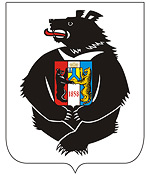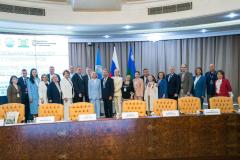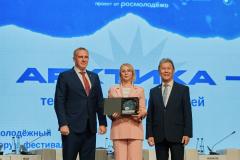Khabarovsk Krai is a federal subject of Russia located in the center of the Russian Far East, part of the Far Eastern Federal District. Khabarovsk is the capital city of the region.
The population of Khabarovsk Krai is about 1,299,000 (2022), the area - 787,633 sq. km.
Governor

Mikhail Degtyarev
Contact Person

Valentina Filonenko
The capital city of Khabarovsk krai: Khabarovsk.
Overview
Khabarovsk Krai is a federal subject of Russia located in the center of the Russian Far East, part of the Far Eastern Federal District.
The population of Khabarovsk Krai is about 1,299,000 (2022), the area - 787,633 sq. km.
Flag and Coat of Arms


History
Exploration of the Far Eastern territories begins from the XVII century. Russian explorers went east to “check on new lands”, bring them under the sovereign’s hand and establish trade links.
In 1639 the group of Tomsk Cossacks, headed by Ivan Yuryevich Moskvitin, reached the Okhotsk Sea. At the mouth of the Ulya River the first ostrog (small fort) was founded. The Cossacks investigated the seashores and collected first information about the Amur. In 1643 Yakutsk voevodstvo (local authority of the time) sent a troop of Cossacks, under leadership of Vasiliy Danilovich Poyarkov, to search for unknown Dauriya land (how they called the western Priamurye) was founded. It was a big expedition of 132 people. From the Aldan, the arm of the river Lena, the Cossacks went over to the basin of the River Zeya and to the River Gonama. One part of the troop stayed here for winter, and the other part went forward. In spring of the next year, having gone down to the River Zeya, the troop reached the Amur. Poyarkov put together quite a complete description of the river, economy and way of life of the local peoples. From the lower course of the Amur Poyarkov made for the stormy Okhotsk Sea on boats, reached the mouth of the Ulya River, and from there returned to Yakutsk.
Administrative and territorial division
Khabarovsk krai comprises 2 Urban districts (okrugs) and 17 Municipal districts, in whose territories there are 29 urban settlements and 427 rural-type settlements. The administrative center of the krai – the city of Khabarovsk - has also been a center of the Far-Eastern Federal District beginning from May of 2002.
Khabarovsk krai is among the largest by size administrative and territorial entities of the Russian Federation; it is located in the central part of the Russian Far East. It borders on regions of the Far Eastern Federal District, and also the PRC.
Geography and climate
KHABAROVSK KRAI is located in the center of the Russian Far East. Its territory is crossed by overland, water and air routes, which connect inner regions of Russia with ports of the Pacific Ocean, and the CIS and West Europe countries with the States of Asia Pacific Region.
Khabarovsk krai is one of the largest regions of the Russian Federation. Its area is 787.0 thousand square meters, which is 4.5 percents of the entire territory of Russia, or 12.7 % of the Far-Eastern economic region. The territory of the krai spreads over for almost 1800 kilometers from north to south, and for 125-170 kilometers from west to east. The distance from its center to Moscow is 8533 km by rail, and 6075 km by air.
The region is washed by the waters of the Okhotsk Sea and the Sea of Japan (the Tatar Strait). The cost line extent (including Islands, the largest of which are the Shantars) is 3390 kilometers.
On the coast of the Tatar Strait there are water areas convenient for constructing ports, such as the Chikhachev Gulf and Vanino Bay, and a unique complex of deep-through, well protected and wide bays, which form the Gulf of Sovetskaya Gavan. This Gulf and the neighboring Vanino Bay are accessible for ships in winter season. A well developed river net is typical for the region. Its biggest part belongs to the Pacific Ocean basin (the Amur Basin Rivers), the smallest part – to the Arctic Ocean basin (the Lena Basin Rivers).
The region borders on China. The nearest neighbors in the Russian territory are Primorsky krai, Jewish Autonomous Oblast, Amur and Magadan Oblasts, Sakha (Yakutia) Republic.
The climatic conditions in Khabarovsk krai change when moving from north to south, they depend on closeness to the sea and on form and pattern of relief. The annual precipitation changes from 400—600 mm in the north to up to 600—800 mm in valleys and eastern slopes of the ranges. In the north of the region the 90% of precipitation fall from April till October, there is especially much precipitation in July and August.
Seasons of the year in the region have strongly marked seasonal differences. Winter in the region is long, with little snow and is severe. The average temperature of January begins from -22°C in the south and is down to -40 °C in the north, on the coast from -18 °C to down to -24 °C. Spring in the most part of the territory begins in March and is featured by unstable weather: warm sunny days are quickly and often changed by cold and rainy ones. Summer is very hot (+28°С - +33°С) and humid. The average temperature of July in the south is +25 °C, in the north around +15 °C. The beginning of the autumn is regarded to be the best year season: it’s dry and warm, the cold comes in November. Winter is featured by clear weather with strong frosts (down to -35°С) and winds, and that’s why the clothes should be very warm (fur coats, feather jackets and etc.). Recommended seasons for visiting are the end of spring – the beginning of summer, the end of summer – the beginning of autumn.



























